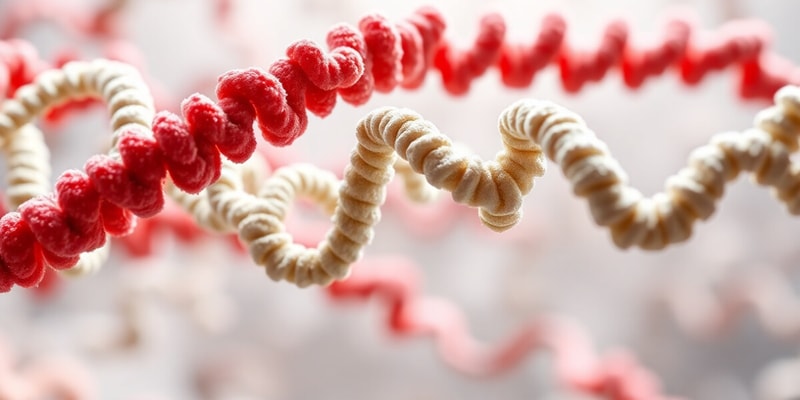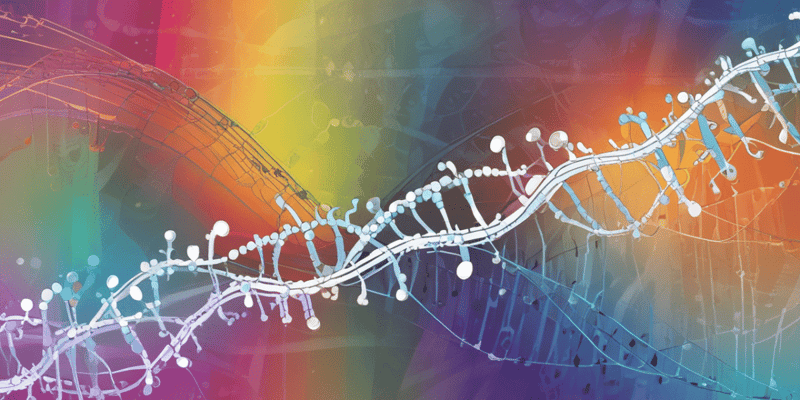Podcast
Questions and Answers
What is the primary role of transcriptional factors in gene expression?
What is the primary role of transcriptional factors in gene expression?
How does alternative splicing affect protein synthesis?
How does alternative splicing affect protein synthesis?
Which process would likely decrease the amount of protein produced from a gene?
Which process would likely decrease the amount of protein produced from a gene?
What is the importance of post-translational modification (PTM) in protein functionality?
What is the importance of post-translational modification (PTM) in protein functionality?
Signup and view all the answers
In the context of gene expression, what is a consequence of transcriptional regulation?
In the context of gene expression, what is a consequence of transcriptional regulation?
Signup and view all the answers
Which of the following is NOT a type of post-translational modification (PTM)?
Which of the following is NOT a type of post-translational modification (PTM)?
Signup and view all the answers
What is the primary role of transcriptional factors in the regulation of gene expression?
What is the primary role of transcriptional factors in the regulation of gene expression?
Signup and view all the answers
Which process contributes to the diversity of proteins synthesized from a single gene?
Which process contributes to the diversity of proteins synthesized from a single gene?
Signup and view all the answers
What is a potential consequence of mutations in genes associated with Amelogenesis imperfecta?
What is a potential consequence of mutations in genes associated with Amelogenesis imperfecta?
Signup and view all the answers
In response to environmental changes, one key mechanism that regulates gene expression involves the:
In response to environmental changes, one key mechanism that regulates gene expression involves the:
Signup and view all the answers
Study Notes
Protein Functions
- Proteins have a wide range of functions within the body, including structural support, catalysis, transport, signaling, and defense.
- The process of turning DNA into a protein involves two steps: transcription and translation.
- Transcription is the process of copying DNA into RNA.
- Translation is the process of translating RNA into a protein.
Protein Synthesis
- Protein synthesis begins with the process of transcription, where DNA is used as a template to create a messenger RNA (mRNA) molecule.
- The mRNA molecule then travels to the ribosomes, where it is translated into a protein.
Protein Folding
- After being synthesized, proteins must fold into their correct three-dimensional shape in order to function properly.
- The folding process is complex and is influenced by a number of factors, including the amino acid sequence of the protein, the environment in which it folds, and the presence of chaperone proteins.
- Misfolding can lead to protein aggregation and disease.
- Chaperone proteins assist in the proper folding of other proteins.
Alternative Splicing
- A single gene can code for multiple proteins through alternative splicing.
- Alternative splicing allows for the production of different protein isoforms from the same gene.
- This process is highly regulated and can be influenced by various factors, including the developmental stage of the cell, the environment, and the presence of specific proteins.
Post Translational Modification (PTM)
- PTMs are modifications that occur to a protein after it has been translated.
- PTMs can alter the function, stability, or localization of a protein.
- PTMs can be reversible or irreversible.
Types of PTM
- Phosphorylation
- Glycosylation
The Proteome
- The proteome refers to the complete set of proteins expressed by a cell or organism at a specific time.
- The proteome is dynamic and changes in response to various factors, such as development, environmental changes, and disease.
Gene Expression
- The process of gene expression involves transcriptional regulation, which controls the production of mRNA molecules.
- Transcriptional factors bind to specific regions of DNA to regulate the rate of transcription.
- mRNA degradation is a crucial process that ensures proper gene expression.
Proteins and Tissues
- Proteins are essential for the development and function of various tissues.
- For example, collagen, keratin, and elastin are important structural proteins found in skin, hair, and connective tissues.
Clinical Relevance
- Mutations in genes that encode for proteins can cause a variety of diseases.
- Amelogenesis imperfecta is a genetic disorder that affects the development of tooth enamel, often caused by mutations in genes involved in enamel protein production.
- Cleft lip and palate is a birth defect that occurs when the lip or palate does not close properly during fetal development.
- This condition can be caused by mutations in genes, environmental factors, or both.
Protein Functions
- Proteins perform a wide range of essential functions in living organisms.
- These functions include structural support, catalysis, transport, signaling, and defense against disease.
DNA to Protein
- DNA is transcribed into RNA, which is then translated into protein.
Protein Synthesis
- Protein synthesis occurs in ribosomes, which are located in the cytoplasm of cells.
- Ribosomes read the genetic code encoded in mRNA and assemble amino acids into polypeptide chains.
Protein Folding
- After synthesis, polypeptide chains fold into specific three-dimensional structures.
- This folding is crucial for protein function.
- The folded structure of a protein is determined by its amino acid sequence and interactions with its environment.
- The folded structure also influences the protein's interactions with other molecules.
Alternative Splicing
- Alternative splicing allows for the production of multiple protein isoforms from a single gene.
- This increases the diversity of proteins that can be produced from the genome.
- The process involves the selective inclusion or exclusion of exons during mRNA splicing, resulting in different mRNA molecules and ultimately different protein products.
Post-Translational Modification
- Proteins can undergo post-translational modifications after they are synthesized.
- These modifications can alter the protein's function, stability, and localization.
- Common types of PTMs include phosphorylation, glycosylation, and acetylation.
Types of PTMs
- Phosphorylation: Addition of a phosphate group.
- Glycosylation: Addition of a carbohydrate group.
The Proteome
- The proteome refers to the complete set of proteins produced by an organism.
Gene Expression
- Gene expression is the process by which genetic information is used to synthesize gene products.
- It involves transcription and translation.
- Transcriptional regulations are crucial for controlling the amount of mRNA produced and subsequently, the amount of protein produced.
Transcriptional Regulation
- Transcriptional factors bind to DNA regions near the coding region.
- They either promote or inhibit the process of mRNA synthesis.
- This regulation allows for the difference in cell types and their responses to the environment (e.g., insulin regulation).
mRNA Degradation
- mRNA can be degraded intentionally to remove the message and reduce the translation of the gene.
Proteins and Tissues
- Different cell types express different sets of proteins, leading to the diversity of tissues and organs in the body.
Example of Protein and Tissue Relationships
- Muscles contain large amounts of myosin and actin proteins for contraction.
- Collagen is a major component of connective tissues.
- Hemoglobin in erythrocytes facilitates oxygen transport.
Clinical Relevance
- Mutations in genes encoding proteins can lead to diseases.
- Amelogenesis imperfecta is a genetic disorder caused by mutations in genes responsible for enamel formation in teeth.
- Cleft lip and palate are birth defects that can be caused by genetic mutations in genes involved in craniofacial development.
Studying That Suits You
Use AI to generate personalized quizzes and flashcards to suit your learning preferences.
Related Documents
Description
This quiz covers the essential functions of proteins, the processes of transcription and translation involved in protein synthesis, and the importance of protein folding. Understand how DNA codes for proteins and the factors that influence their three-dimensional structures.




